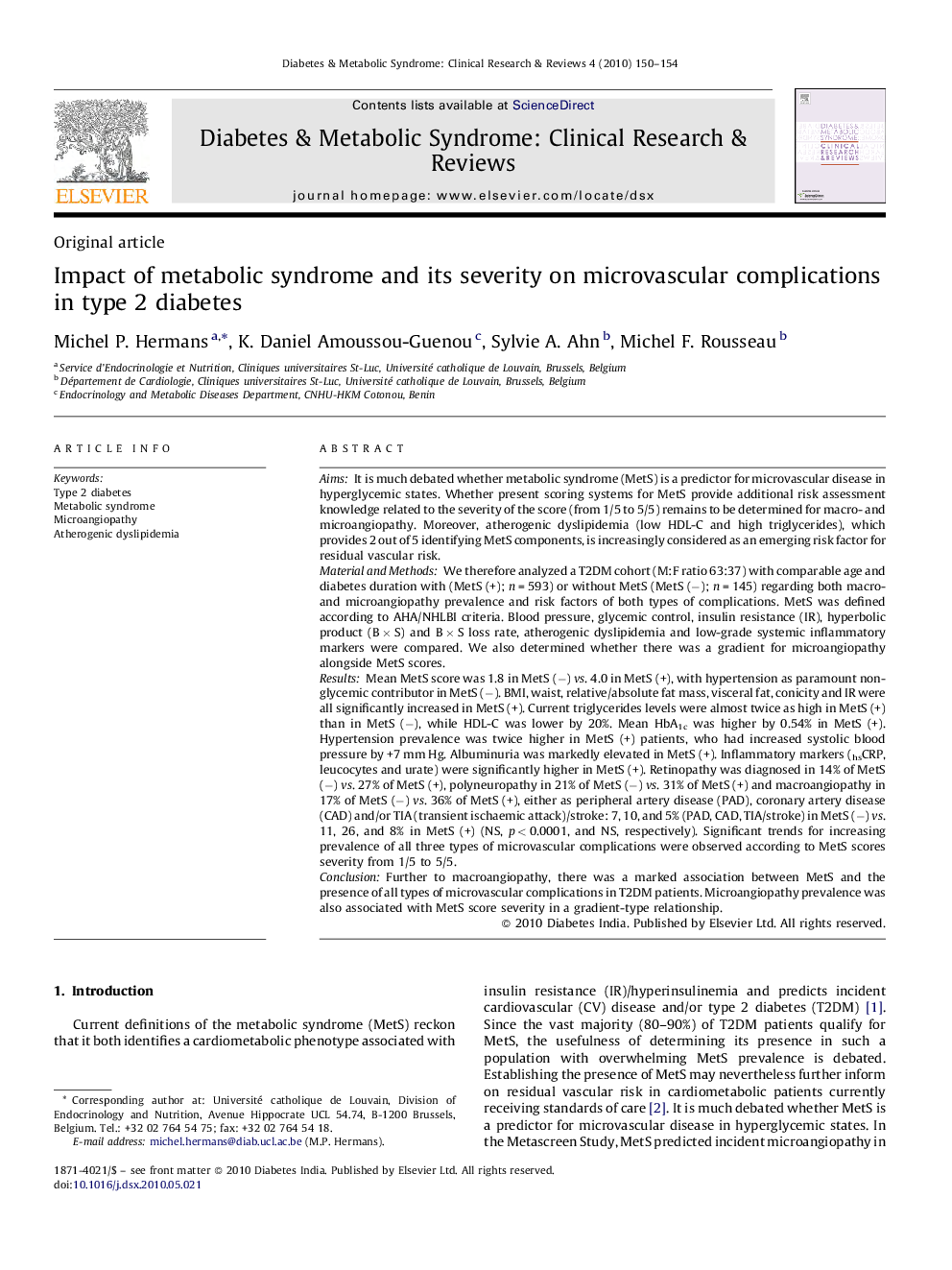| کد مقاله | کد نشریه | سال انتشار | مقاله انگلیسی | نسخه تمام متن |
|---|---|---|---|---|
| 2910088 | 1174603 | 2010 | 5 صفحه PDF | دانلود رایگان |

AimsIt is much debated whether metabolic syndrome (MetS) is a predictor for microvascular disease in hyperglycemic states. Whether present scoring systems for MetS provide additional risk assessment knowledge related to the severity of the score (from 1/5 to 5/5) remains to be determined for macro- and microangiopathy. Moreover, atherogenic dyslipidemia (low HDL-C and high triglycerides), which provides 2 out of 5 identifying MetS components, is increasingly considered as an emerging risk factor for residual vascular risk.Material and MethodsWe therefore analyzed a T2DM cohort (M:F ratio 63:37) with comparable age and diabetes duration with (MetS (+); n = 593) or without MetS (MetS (−); n = 145) regarding both macro- and microangiopathy prevalence and risk factors of both types of complications. MetS was defined according to AHA/NHLBI criteria. Blood pressure, glycemic control, insulin resistance (IR), hyperbolic product (B × S) and B × S loss rate, atherogenic dyslipidemia and low-grade systemic inflammatory markers were compared. We also determined whether there was a gradient for microangiopathy alongside MetS scores.ResultsMean MetS score was 1.8 in MetS (−) vs. 4.0 in MetS (+), with hypertension as paramount non-glycemic contributor in MetS (−). BMI, waist, relative/absolute fat mass, visceral fat, conicity and IR were all significantly increased in MetS (+). Current triglycerides levels were almost twice as high in MetS (+) than in MetS (−), while HDL-C was lower by 20%. Mean HbA1c was higher by 0.54% in MetS (+). Hypertension prevalence was twice higher in MetS (+) patients, who had increased systolic blood pressure by +7 mm Hg. Albuminuria was markedly elevated in MetS (+). Inflammatory markers (hsCRP, leucocytes and urate) were significantly higher in MetS (+). Retinopathy was diagnosed in 14% of MetS (−) vs. 27% of MetS (+), polyneuropathy in 21% of MetS (−) vs. 31% of MetS (+) and macroangiopathy in 17% of MetS (−) vs. 36% of MetS (+), either as peripheral artery disease (PAD), coronary artery disease (CAD) and/or TIA (transient ischaemic attack)/stroke: 7, 10, and 5% (PAD, CAD, TIA/stroke) in MetS (−) vs. 11, 26, and 8% in MetS (+) (NS, p < 0.0001, and NS, respectively). Significant trends for increasing prevalence of all three types of microvascular complications were observed according to MetS scores severity from 1/5 to 5/5.ConclusionFurther to macroangiopathy, there was a marked association between MetS and the presence of all types of microvascular complications in T2DM patients. Microangiopathy prevalence was also associated with MetS score severity in a gradient-type relationship.
Journal: Diabetes & Metabolic Syndrome: Clinical Research & Reviews - Volume 4, Issue 3, July–September 2010, Pages 150–154